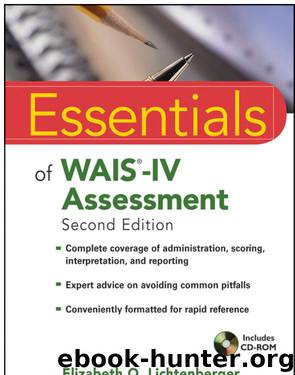Essentials of WAIS®-IV Assessment by Elizabeth O. Lichtenberger Alan S. Kaufman

Author:Elizabeth O. Lichtenberger, Alan S. Kaufman
Language: eng
Format: epub
Publisher: John Wiley & Sons
Published: 2012-10-15T16:00:00+00:00
What Do the Processing Speed Subtests Measure?
The Processing Speed Index (PSI) subtests were designed primarily to assess processing speed with nonverbal, visual stimuli. Assessment of processing speed therefore is the primary focus of interpretation of the PSI, as well as for the individual PSI subtests. The WAIS-IV includes a new supplementary subtest called Cancellation. The role of processing speed in PSI subtest performance is discussed in Appendix B.17.
Beyond the primary cognitive construct targeted for assessment with the PSI subtests, the specific formats of each subtest make demands on the examinee that require the engagement of additional cognitive constructs in order to achieve success. Although these constructs typically are required for effective subtest performance, they are not considered to be the primary target of the assessment (i.e., the intention of the subtest is not to quantitatively assess the examinee's use of these cognitive constructs). These secondary cognitive constructs include Visual Discrimination, Graphomotor abilities/skills, Attention to Visually Presented Information, and multiple Executive Functions applied to cue and direct the use of visual processing and processing speed resources. The roles of these secondary cognitive constructs in subtest performance are described in detail in Appendix B.17. Clinicians familiar with the WISC-IV Cancellation subtest should make note of the substantial difference in the kind of executive functions most likely to be involved in performance of the WAIS-IV Cancellation subtest compared to those involved with the WISC-IV Cancellation subtest.
It is important to recognize that the PSI comprising the Coding and Symbol Search subtests offers a fairly limited measure of processing speed. All three of the PSI subtests employ a visual presentation format that requires the processing of nonverbal visual stimuli and graphomotor responses. The WAIS-IV PSI subtests do not address processing speed directly applied to academic tasks such as the fluent reading or writing of words or the completion of math problems. As a result of this narrow focus of input, processing, and output demands, PSI scores have limited generalizability to academic settings or work settings involving these academic skills. Clinicians who wish to know about an examinee's processing speed for reading cannot infer this from the PSI score or the individual Symbol Search, Coding, or Cancellation subtest scores. Such information needs to be obtained from one or more specific measures of reading speed. From a process approach perspective, however, there is a link between performance on the Coding subtest and written expression production.
Don't Forget
Cognitive Constructs Most Likely to Be Involved in Processing Speed Tasks
Primary Constructs Targeted for Assessment Visual processing speed
Motor processing speed
Visual-motor processing speed
Download
This site does not store any files on its server. We only index and link to content provided by other sites. Please contact the content providers to delete copyright contents if any and email us, we'll remove relevant links or contents immediately.
Rewire Your Anxious Brain by Catherine M. Pittman(17581)
Talking to Strangers by Malcolm Gladwell(11865)
The Art of Thinking Clearly by Rolf Dobelli(8836)
Mindhunter: Inside the FBI's Elite Serial Crime Unit by John E. Douglas & Mark Olshaker(7830)
Becoming Supernatural by Dr. Joe Dispenza(7100)
Change Your Questions, Change Your Life by Marilee Adams(6637)
Nudge - Improving Decisions about Health, Wealth, and Happiness by Thaler Sunstein(6629)
The Road Less Traveled by M. Scott Peck(6627)
The Lost Art of Listening by Michael P. Nichols(6465)
Enlightenment Now: The Case for Reason, Science, Humanism, and Progress by Steven Pinker(6404)
Win Bigly by Scott Adams(6306)
Mastermind: How to Think Like Sherlock Holmes by Maria Konnikova(6227)
The Way of Zen by Alan W. Watts(5790)
Daring Greatly by Brene Brown(5636)
Grit by Angela Duckworth(4729)
Big Magic: Creative Living Beyond Fear by Elizabeth Gilbert(4719)
Men In Love by Nancy Friday(4315)
Flow by Mihaly Csikszentmihalyi(4047)
The Four Tendencies by Gretchen Rubin(4018)
